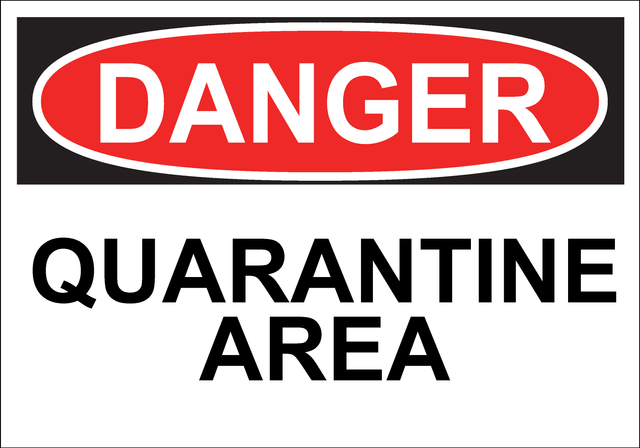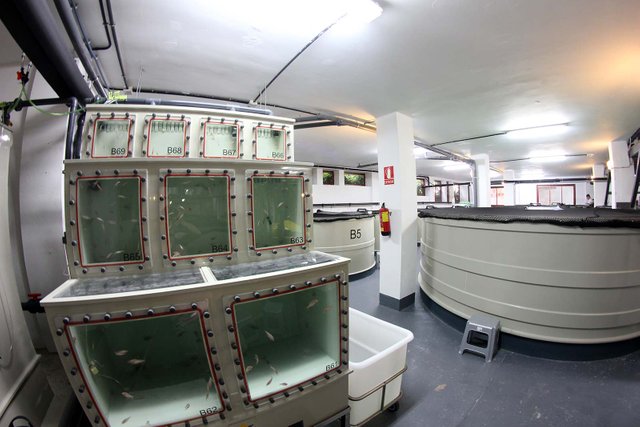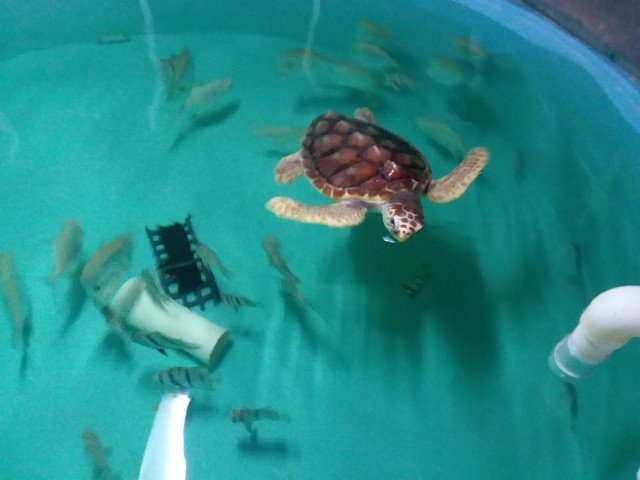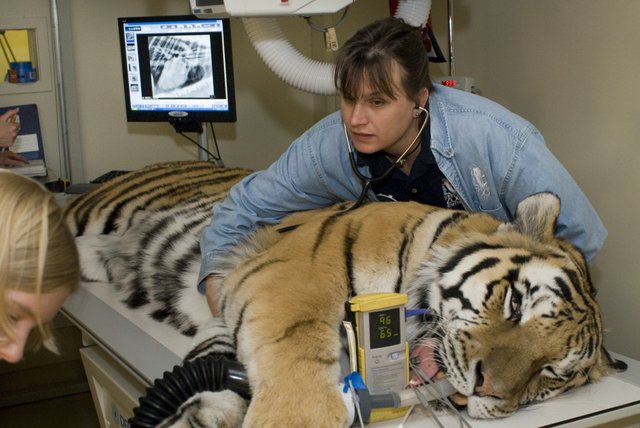Working in an Animal Care Facility: Quarantine Procedures
A zookeepers job is all about providing the best possible care for their animals, keeping them happy and healthy despite their captivity. A huge amount of planning and effort goes into promoting animal welfare, and countless protocols and procedures allow the animals to live the best lives they possibly can. Among these are quarantine procedures; through such procedures, zoos and aquariums around the world keep their animals safe from disease and injury. This post is another "behind-the-scenes" look at some of the hidden work that goes on at your local animal care facility...work that has a profound impact on the welfare of the animals housed there.

Countless movies, TV shows and books have us imagining quarantine as the most extreme measures taken to stop the outbreak of a disease. Government agents in hazmat suits locking people in against their will in a last ditch effort to control a plague. Obviously, that is nothing like the kind of quarantine we are talking about here. Though strict rules and regulations are in place for the safety of the animals, our quarantine rooms are tailored to the comfort of the animals housed within. For the most part, our quarantine process is more preliminary in nature, seeking to prevent problems before they arise as opposed to responding to an existing threat to animal health.

The best form of treatment is prevention. As soon as animals arrive at a facility, they are immediately quarantined. They are set up in a separate holding area where they are unable to interact with other animals in the facility's care. It doesn't matter if the animal is a tiny fish or a giant elephant; all animals must pass this stage before they can be accessed into the collection. Eggs are incubated in quarantine as well, and newly-hatched animals must pass through the same process. As soon as they arrive, the animal is looked over by a vet and set up in an appropriate enclosure simulating their exhibit. According to regulations, the animal must remain in quarantine for a minimum of 30 days, during which keepers and vets will closely monitor the animal and keep track of its weight, food intake, and overall behavior. During this time, the keepers will also collect regular fecal samples to be tested for a number of parasites; if these tests indicate a parasitic presence, the vet will prescribe a treatment regimen. Once 30 days have passed and the animal has had 3 consecutive fecal samples bearing no parasites, it will face a final veterinary evaluation, then can be removed from quarantine and united with our other animals.

Our newest loggerhead turtle is about halfway through his/her quarantine period. Once cleared, he/she will be introduced to our Chesapeake Bay Aquarium.
Life, of course, still throws some surprises our way. Sometimes animals get sick or injured and need some sort of treatment. Animals that are suspected to be ill are quarantined to control the spread of a possible disease, and every animal in the enclosure will be treated as a preventative measure. Injured animals are removed to be allowed to heal in a less stressful environment (for example, one of our anole lizards suffered a mild injury after falling off a branch; the injury made it difficult to catch food before other anoles could). Sick/injured animals are immediately pulled from exhibit and taken to a vet (onsite or offsite depending on severity and type of health issue). The animal will be kept separate until the end of treatment, at which point they are slowly reintroduced back into their exhibit under a vet's observation.

A quarantine plan must be filed for each individual animal. The procedures must be tailored to each individual species, to be practical and effective in improving animal health. While many of the procedures are concrete, they may change at the recommendation of a vet team if the animal has particularly special needs or requires further treatment. While the Association of Zoos and Aquariums does strongly recommend certain procedures, it is largely left up to these facilities and vets to create standard operating procedures that best suit their capabilities and the animals. Our own facility acquired two common mudpuppies that were known carriers of the chytrid fungus, a devastating disease wiping out amphibians around the world. Through a specially tailored treatment lasting 2 1/2 years, we were successfully able to rid the two amphibians of the fungus, and they are awaiting the transfer to their new exhibit.

In order to keep quarantine...well quarantined, we do not interact with any of these animals until we have completed all work with our existing collection. During our morning check-in, we ensure that all animals look healthy and all systems are up and running; if anything looks out of the ordinary, a vet is called or a keeper steps in to help (the keeper is sent home after working in quarantine). Once all animal tasks have been completed, we start our quarantine tasks; all feeding, cleaning and medicating happens at the very end of the day. Our quarantine rooms are equipped with a separate set of tools, supplies, food, even a separate water supply to prevent cross contamination. Once work is completed in quarantine, staff are asked to use foot baths and are sent home. If it sounds like overkill, it's only because we want to ensure the health and safety of our animals.

Quarantine is just another one of those things almost no one thinks about when visiting zoos and aquariums. They are so separated from the public that most people don't even realize such strict policies exist, yet these procedures are crucial to maintaining excellent health. Yes, it's frustrating when zoos don't put new or baby animals on exhibit immediately, but this is just to ensure that the animal will be around to visit and enjoy for a long time to come!

Question - if your turtle is in quarantine, why is it swimming with a bunch of fish? This pic confused me a little bit on the process you were describing, likely because I misunderstood. I thought they needed to be isolated.
Do some animals experience any detrimental effects from not getting any sunlight for 30+ days?
Those are great questions! So generally yes, the animals are isolated, however they can be housed with other animals that they were previously housed with. For example, these fish are from the same tank the sea turtle came from at another aquarium. Since they were housed in the same system, there isn't really a risk of cross contamination; if the turtle had something, they would too and vice-versa (fortunately, nothing has turned up for either). So in quarantine, some animals will be housed together, like the mudpuppies I mentioned in the post, because they require the same environment and treatments. Animals that come in on their own are always housed separately; this is more often the case. That wasn't made clear by the post at all.
When I say the animals are provided with everything they need, that includes "sunlight". Living without any sunlight for 30+ days would absolutely be detrimental to health; we do have animals that suffered from previous captivity in an environment without proper ultraviolet radiation. All enclosures are set up with both heating lamps and UV emitting bulbs that simulate natural sunlight, and these lights are on timers that mimic natural day/night cycles. Using UV meters, we can be sure that when these animals are basking, they are receiving the same levels of UV that they would if they were outside. Even on exhibit, these animals won't recieve true sunlight because they are inside, but the bulbs do provide them with the light, heat, and UV that the sun naturally provides. This is clearly observable to guests too; during the "night" cycle, many of our reptiles hunker down while during the "daytime" cycle, they bask, flaunt some impressive colors, and even display mating behaviors!
(Thanks for your thoughtful reply btw.)
Hello ! I just see your content, I love it.Follow me @kunalparikh and I follow you too!
I like it a very rare topic.
This is a fantastic post, @herpetologyguy. Quite undervalued as far as those of us at TARC are concerned. TARC is a rescue in Central Appalachia. Although we deal mostly with dogs, the quarantine procedures you describe here are very familiar. Unfortunately, they're sadly underused by most rescues and even public animal shelters. We'll probably be doing a post on our quarantine procedures soon, as well. They differ somewhat in practical execution, but not in theory or effectiveness--basically, they're structured to accommodate dogs more than turtles or tigers. LOL Although we do have one raccoon who thinks she's a rescue dog. . . .
Thank you so much for sharing this. It was a great read, right up my alley. (I'm the rescue Director, posting on behalf of our group.)
Good day. By allowing animal lovers from all over the world to positively impact the lives of countless animals in need, The Animal Rescue Site has gained great popularity. With a simple click, visitors can provide vital support to animal shelters. If you want to make a positive impact on the lives of animals, you can contact the animal rescue site customer service and get a consultation with their representative, and this will allow you to understand how you can be useful to this organization.